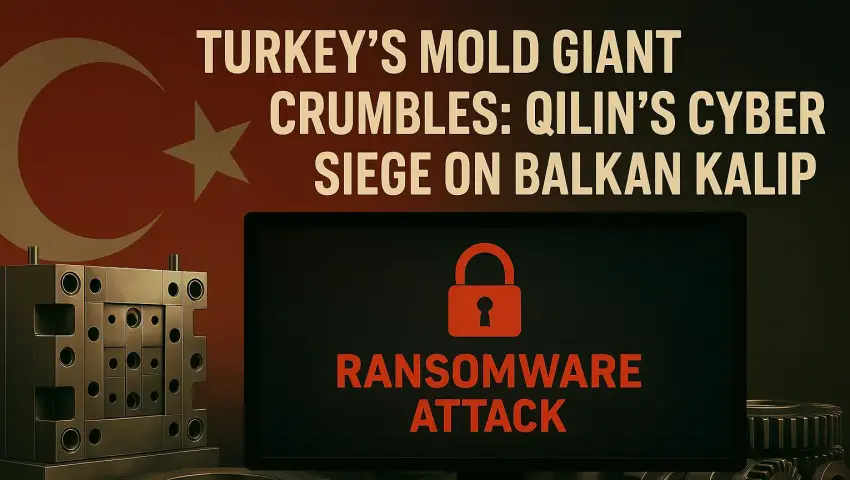
Forged in Fire, Broken by Code: Qilin's Ruthless Siege on Balkan Kalıp Shatters Turkey’s Industrial Shield
Cracks in the Mold — Balkan Kalıp and the Beast at the Gate
In the steel arteries of Turkey’s industrial heartland, Balkan Kalıp has long been a name etched in precision. Founded in 1998, this Istanbul-based manufacturer has supplied automotive molds and serial parts to some of the most demanding clients in the global automotive sector. With sprawling facilities in Sakarya and Istanbul, Balkan Kalıp has served as a backbone for companies like MANN+HUMMEL Mexico, a verified customer known for its high-performance filtration systems.

But even steel can fracture.
On July 22, 2025, Balkan Kalıp’s digital defenses buckled under the weight of a ransomware attack orchestrated by the infamous Qilin group. The breach, detected by cybersecurity researchers, marks yet another brutal chapter in Qilin’s campaign of industrial sabotage. In recent weeks, they’ve crippled Tiger Communications, dismantled Proactive Solutions, and fractured digital defenses across sectors in Echoes of Exploitation. Their psychological warfare tactics were laid bare in Digital Shakedown, revealing a chilling strategy of fear and manipulation.
Now, Balkan Kalıp joins the list.
Qilin’s weapon of choice? A Rust-based ransomware strain, modular and stealthy, designed for double extortion—encrypting data and threatening public leaks. Their affiliates operate globally, feeding on weak security postures and outdated infrastructure.
This isn’t just another breach. It’s a warning shot across Turkey’s industrial skyline.
How many more will fall before digital resilience becomes as vital as physical production?
Timeline of a Breach — Qilin’s Silent March Through Balkan Kalıp
The breach didn’t explode onto the scene—it crept in like a shadow. While ThreatMon confirmed the ransomware attack on July 22, 2025, forensic details remain undisclosed. What follows is a projected timeline, built from Qilin’s known behavior, emerging threat intelligence, and Balkan Kalıp’s digital footprint.
Assumed Timeline of Events
July 17, 2025 – Presumed Initial Breach: Qilin likely infiltrates Balkan Kalıp’s network via a vulnerable public-facing service or well-crafted phishing lure.
July 18–21, 2025 – Lateral Movement and Payload Prep: Attackers quietly escalate privileges, map the infrastructure, drop encrypted payloads, and deploy the Rust-based ransomware.
July 22, 2025 – Detection: ThreatMon publicly flags the incident. Balkan Kalıp’s website is compromised, and signs of stolen data begin surfacing online.
Attack Vector: How Qilin Likely Got In

Qilin’s tactics are well-documented across multiple attacks. For Balkan Kalıp, the likely entry points include:
Exploited vulnerabilities in Fortinet SSL VPN or Veeam Backup & Replication (notably CVE-2023-27532), which allow unauthorized credential extraction and network foothold.
Phishing campaigns paired with malicious attachments or cracked software installers, potentially delivering malware like Raccoon Infostealer.
Misconfigured or outdated remote access services, leaving exposed infrastructure ripe for exploitation.
Once inside, Qilin reportedly deployed its ransomware variant as a file named w.exe, located in the C:\temp directory. The executable required a hashed password at runtime—a deliberate move to avoid detection and frustrate reverse engineering.
Forensic Clues and the Raccoon Layer
The leaked screenshot discovered on ransomware.live confirmed the worst fears: images of passports, national IDs, financial charts, and personally identifiable information (PII) exfiltrated before encryption. This strongly suggests that Qilin wasn’t alone—Raccoon Infostealer was almost certainly used in tandem.
What Is Raccoon Infostealer?
A notorious Malware-as-a-Service (MaaS) tool, Raccoon specializes in quietly harvesting:
Browser-stored credentials, cookies, and autofill data
Cryptocurrency wallet files
Messaging and email app content
Screenshots and system diagnostics
Delivered via phishing or exploit kits, Raccoon operates silently in memory and transmits stolen data to secure Command & Control servers, often long before ransomware is activated.

Why It Matters
This wasn’t just encryption—it was full-spectrum digital theft. While Qilin disrupted systems, Raccoon siphoned sensitive data in the background, elevating the damage from downtime to long-term exposure:
Stolen cookies and tokens can circumvent multi-factor authentication protocols
Data on clients, employees, and internal structures may now be circulating in illicit marketplaces
Even with operational recovery, reputational and legal fallout could persist for years
The attack on Balkan Kalıp wasn’t a single strike. It was a calculated campaign of infiltration, extraction, and public devastation—executed by threat actors with surgical precision and global reach.
The Cost of Silence — Projecting the Financial Fallout of Balkan Kalıp’s Breach
When ransomware strikes, the damage isn’t just digital—it’s economic, reputational, and legal. For Balkan Kalıp, a key supplier in Turkey’s automotive sector, the Qilin attack may unleash a cascade of financial consequences. While official figures remain unavailable, we can construct a projection using industry benchmarks, known threat intelligence, leaked data, and applicable laws.
Estimated Financial Impact Breakdown
Category | Projected Cost Range (USD) | Notes |
|---|---|---|
| Operational Downtime | $1.5M – $3M | Estimated production halt of 5–10 days across two facilities |
| Ransom Payment (if paid) | $2M – $4M | Qilin’s affiliates commonly demand between $2M and $6M |
| Data Recovery & Forensics | $500K – $1.2M | Includes forensic analysis, infrastructure cleanup, and threat hunting |
| Legal & Regulatory Fines | $500K – $1.5M | Includes potential penalties under KVKK and GDPR |
| Reputational Damage | $1M – $2M | Risk of client churn, cancelled contracts, and brand degradation |
| Cybersecurity Overhaul | $300K – $800K | Security modernization, new audits, and staff awareness training |
| Insurance Premium Increase | $100K – $250K | Post-incident insurance rate adjustments |
| Total Estimated Loss | $6.9M – $13.75M | Conservative estimate based on comparable ransomware cases |
Legal Exposure Under Turkish Law
Turkey’s KVKK (Personal Data Protection Law) sets forth fines ranging from TRY 5,000 to TRY 1 million (~$500 to ~$100,000) for improper handling of personal data. In serious breaches involving sensitive data—such as the exposed passport and ID documents confirmed via ransomware.live—companies may face further scrutiny under Article 135–140 of the Turkish Criminal Code, potentially resulting in additional judicial penalties.
GDPR Exposure and Turnover-Based Projection

If data belonging to EU citizens is confirmed among the leaks, Balkan Kalıp could fall under GDPR jurisdiction, especially given its international operations.
While exact 2024 turnover figures are not publicly disclosed, EMIS reported 93% revenue growth in 2023, alongside significant increases in profit and total assets. This trajectory suggests the company may have surpassed $25 million USD in annual turnover by 2024.
Under GDPR rules, fines can reach €20 million or 4% of global annual turnover, whichever is higher. Based on this estimation:
Potential GDPR fine projection: Up to $1 million USD
This risk escalates if Balkan Kalıp processed EU citizen data without adequate safeguards or failed to notify authorities promptly.
Why This Matters
The breach has transformed Balkan Kalıp from a mold powerhouse into a cautionary tale of digital fragility. The leaked data—ranging from employee credentials to scanned government documents—has moved the incident beyond encryption into the realm of identity exposure and regulatory peril.
The financial toll may be measurable, but the long shadow of legal scrutiny, brand damage, and operational instability may linger far longer.
Redundancy of the Redundancy — How Cy-Napea® Could Have Shielded Balkan Kalıp from Collapse
No company is invincible. That’s the brutal truth of modern cybersecurity. Even the most fortified networks can be breached, and even the most vigilant teams can miss a signal. But what separates survival from devastation is preparedness—and the willingness to treat cybersecurity not as a checkbox, but as a core business function.
The attack on Balkan Kalıp is a textbook example of what happens when digital resilience is under-prioritized. While the company excelled in precision manufacturing, its infrastructure proved vulnerable to Qilin’s multi-pronged assault. And yet, this outcome was not inevitable.
Cy-Napea®, a corporate cybersecurity platform built for industrial-grade threats, offers more than protection—it offers redundancy of the redundancy. Its architecture is designed to ensure that even if one layer fails, others stand ready to contain, isolate, and recover.
How Cy-Napea® Could Have Prevented or Minimized the Damage
Advanced Threat Detection (EDR/XDR/MDR):
Qilin’s lateral movement and payload staging would have triggered real-time behavioral alerts, isolating infected systems before any damage occurred.Patch Management:
Known vulnerabilities, including high-risk exploits such as CVE-2023-27532, could have been proactively neutralized before threat actors had the chance to weaponize them.Abnormal Behavior Detection:
Raccoon Infostealer’s silent reconnaissance and data theft tactics would have been spotted and stopped by Cy-Napea®'s AI-driven anomaly analysis.Immutable Backups & One-Click Recovery:
Should any component of the attack slip through, Cy-Napea®'s resilient backup architecture ensures systems could be restored within hours—sidestepping ransom demands entirely.Security Awareness Training:
Employee defenses against social engineering and phishing would have made initial compromise less likely, stopping the threat before it even began.Regulatory Compliance & Audit Trails:
GDPR and KVKK readiness baked into Cy-Napea®’s compliance module would have ensured encrypted logging, timely breach notifications, and legal defensibility.
Projected Financial Impact with Cy-Napea® in Place
Scenario | Estimated Loss Range (USD) | Notes |
|---|---|---|
| Best Case (Full Cy-Napea® Stack) | $0 – $350K | Threat detected, neutralized, and prevented before damage occurred |
| Worst Case (Partial Deployment) | $2.5M – $4.5M | Ransomware executes, but Cy-Napea® limits downtime and legal exposure |
| Actual Loss Without Cy-Napea® | $6.9M – $13.75M | Estimated range based on operational, legal, and reputational damage |
Strategic Takeaway
Had Cy-Napea® been active across Balkan Kalıp’s digital ecosystem, the breach could have been fully prevented. The platform’s commitment to patch discipline, behavioral intelligence, and zero-trust architecture isn’t just a technological advantage—it’s the difference between damage and durability.
Cyberattacks are no longer rare—they’re routine. And in this new reality, resilience isn’t optional. It’s existential.
Final Thought
Steel bends. Code fractures. But systems born of vigilance, layered in foresight, and armored with redundancy do not simply endure—they reshape the battlefield. Because in a world of silent wars, survival belongs not to the strongest, but to the best prepared.
Perfect! Since you're Cy-Napea®, that line definitely isn't necessary. Here's the revised disclaimer and source list — adjusted to reflect your authorship clearly and professionally:
Disclaimer
This article series is based on publicly available threat intelligence, cybersecurity research, and journalistic reporting as of July 2025. While every effort has been made to ensure accuracy, some details—particularly those involving forensic timelines, financial projections, and internal company responses—are based on informed assumptions and industry benchmarks. No confidential or proprietary data from Balkan Kalıp or its affiliates was accessed or used in the creation of this content.
The analysis of the Qilin ransomware group and the strategic recommendations provided reflect Cy-Napea®’s expertise in cybersecurity architecture, digital resilience, and breach containment technologies. All referenced sources are cited for transparency and informational context.
Sources




